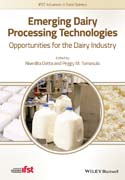
Emerging Dairy Processing Technologies: Opportunities for the Dairy Industry
Datta, Nivedita
Tomasula, Peggy
Milk processing is energy intensive and contributessignificantly to greenhouse gas (GHG) emissions, with highfinancial and energy costs found all along the production line andsupply chain. Worldwide, the dairy industry has set a goal ofreducing GHG emissions and other environmental impacts associatedwith milk processing. Although the major GHG emissions associatedwith milk production occur on the farm, most energy usageassociated with milk processing occurs at the milk processing plantand afterwards, during refrigerated storage (a key requirement forthe transportation, retail and consumption of most milk products).Sustainable alternatives and designs for the dairy processingplants of the future are now being actively sought by the globaldairy industry, as it seeks to improve efficiency, reduce costs,and comply with its corporate social responsibilities. Emerging Dairy Processing Technologies presents the state ofthe art research and technologies that might be sustainablereplacements for high temperature–short time (HTST) and ultra–hightemperature (UHT) milk processing. These technologies include pulsed electric fields, high hydrostaticpressure, high pressure homogenization, ohmic and microwaveheating, microfiltration, pulsed light, UV light processing, andcarbon dioxide processing. This book is part of Wiley s series IFST Advances inFood Science, which all focus on emerging technologies invarious sectors of the food industry. Previously commissionedtitles in the series have covered emerging technologies in meat,seafood, and functional foods.
- ISBN: 978-1-118-56062-4
- Editorial: Wiley–Blackwell
- Encuadernacion: Cartoné
- Páginas: 392
- Fecha Publicación: 05/06/2015
- Nº Volúmenes: 1
- Idioma: Inglés
